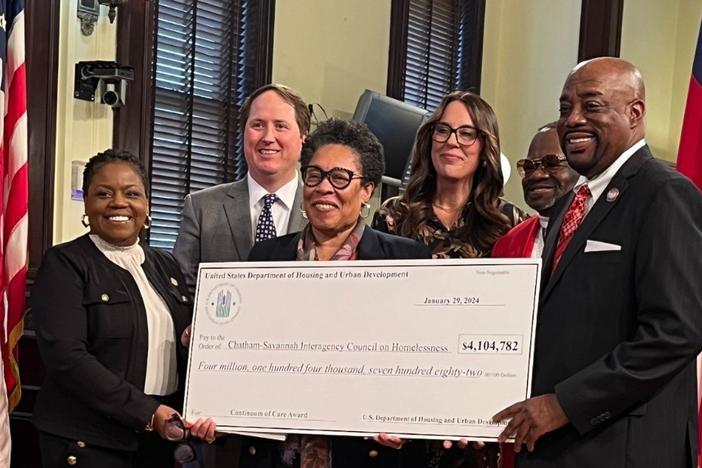Section Branding
Header Content
People of Color Have More Spending Power Than Ever, Report Says
Primary Content
The expression that there's "strength in numbers" is increasingly true as it relates to the buying power of minority groups. Their ability to spend on consumer goods outpaces the national average.
In other words, African Americans, Hispanics, Asian-Americans and Native Americans are able to buy more stuff. That has many businesses scrambling to market their products in a new way.
These trends are detailed in a new analysis by the University of Georgia. Report author and economist Jeffrey Humphries is Director of Economic Forecasting at UGA's Terry College of Business.
He joined GPB's Rickey Bevington to break down his findings.
Rickey Bevington: What trends stand out to you both nationally and locally to Georgia and the Southeast?
Jeffrey Humphries: There are a number of trends. First of all, we are seeing and have been seeing above average growth of these target to minority markets in the United States. So the U.S. Hispanic market, the U.S. African American market, the U.S. Asian consumer markets and the Native American market are all growing faster than the overall consumer market in the United States. It has major implications for businesses, both large and small.
Those trends transcend the U.S. economy, and they are very much present in Georgia. But Georgia's outdoing the nation and several of those markets in terms of the rate of growth. And Georgia now has the third-largest African American market. We're kind of the sweet spot when it comes to African Americans' spending power.
Rickey Bevington: And I understand that's up from recent years.
Jeffrey Humphries: That's right. We have seen tremendous growth. If you look at just the last decade, from 2010 to 2020, the overall U.S. consumer market grew by almost 62%. But if you look at the Black market in Georgia, it grew by 78%. Look at Hispanic market in Georgia: That grew by 83%. If you look at the multiracial consumer market in Georgia, up by 99%. The Asian consumer market up by 138%.
Rickey Bevington: And all of this despite the pandemic because these are 2020 numbers.
Jeffrey Humphries: That's right. Numbers transcend the entire decade. And actually, the pandemic did not have an extremely negative effect on consumer income and consumer spending, a much smaller effect on originally expected, mostly because of the large federal transfer payments to people. And so the buying power numbers held up very well in 2020.
Rickey Bevington: Looking at the Georgia numbers specifically — and they are remarkable — what explains those trends?
Jeffrey Humphries: Well, there are a number of factors. First of all, above average population growth for all of these groups. Second, rising levels of educational attainment. If you look, for example, at the Black consumer market in the state, we have a huge concentration of historically Black colleges and universities sort of centered on Atlanta but spread across the state. Plus, we have a number of public institutions that serve literally thousands of Black students. And so this sort of newly minted talent that adds to the buying power of Black consumers in Georgia, much more so than in the average state.
Third, we have rising levels of entrepreneurial activity, lots of minorities starting their own businesses with Blacks and Hispanics and Asians, all starting business at a faster rate than the overall population. You put that all together and you get some pretty amazing things in terms of consumer spending.
Rickey Bevington: And there are major companies that want their hands on this data and it will influence their marketing and advertising campaigns. How might the average Georgian see these trends in their day-to-day lives?
I think these are manifest or they're easier to see when you look at advertising message, a lot more message, for example, in the Spanish language, a lot more message in Black media, Black radio, Black TV, a lot more content of message focused on racial and ethnic minorities. And beyond that we have a lot of products that are being developed for specific consumers in mind, whether it's cosmetics for darker skin tones or other products. So it is easy to see, particularly if you take the long perspective and look at the way things are now compared to how they were 10, 20 or 30 years ago.
Rickey Bevington: Does this data suggest that African Americans, Hispanics and other groups are more well-off? Can you make that direct a comparison to, say, 10, 20, 30 years ago?
Jeffrey Humphries: I'm looking at income — in other words, annual income. Now, if you look at annual income, certainly Blacks, Hispanics, Asians are much better off than they were 10, 20, 30 years ago. What I have not looked at — and I think that's really where you are going with this question — is wealth. I have not estimated the wealth of these groups. I have only looked at their annual after-tax income. So in terms of after-tax income, all of these groups are much better off than they were 10, 20, 30 years ago. I have not looked at their wealth, which is a very different research methodology.
Rickey Bevington: I can only imagine the changes that you've seen.
Jeffrey Humphries: Yes, I published my first study in 1991, and it is now 2021. So exactly 30 years.
Rickey Bevington: Can you give us some turning points that you've seen?
Jeffrey Humphries: Yeah, I think what I've seen over the decades is when I first started doing this study and then throughout the 1990s, really the primary focus was on the Black consumer of the large corporations and businesses, large and small that called me about the study or that bought copies of the study. They were mostly focused on African American consumers in the 1990s.
Census 2000 was kind of a wakeup call in terms of the Hispanic consumer market. Once the Census 2000 numbers started coming out of my buying power estimates, I think a lot of businesses realized they were sort of behind the curve in terms of marketing to Hispanics and there was a lot of opportunity there. And so I started to get more and more calls and more and more purchases of the study so get companies to get their hands on the Hispanic numbers.
I saw a third shift after the Great Recession. After the Great Recession, the focus really shifted towards the Asian consumer market with a lot more interest in the Asian buying power numbers than I saw prior to the Great Recession. I haven't really seen a shift yet with respect to the COVID-19 recession. I think it's probably too early to know whether that has changed the focus of U.S. businesses.
Rickey Bevington: Well, the data that we're going to be getting will be census data from 2020. Are you concerned that 2020 census data relating to minority groups won't be accurate?
Jeffrey Humphries: There certainly were disruptions to the enormous normal census taking that took place in the year 2020. And the Census Bureau itself is very concerned about the reliability of those estimates because of sampling problems and the like. In fact, I've heard recently that the Census Bureau will probably not issue the American Community Survey data for that year. So there are going to be issues with the data that was gathered in the year 2020. Fortunately, we do the American Community Survey now every year. It's not a decennial census anymore. It's an every-year census which means we can get new data and sort of fill in some of the blanks that were left in the numbers due to the pandemic.
Secondary Content
Bottom Content





